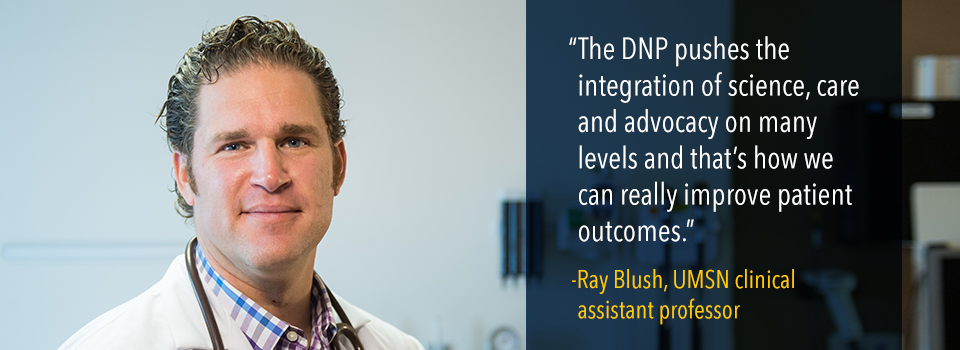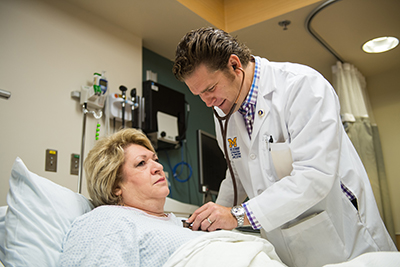Faculty impact: Improving patient outcomes through nurse leadership

When Ray Blush started to think about a career in health care, he initially put physician at the top of the list. That changed when he was an undergraduate student and got a tech job in a hospital.
 “That’s where I began to understand that what I really wanted to do in caring for patients was what the nurses were doing,” he said. “They were the ones really providing the care.”
“That’s where I began to understand that what I really wanted to do in caring for patients was what the nurses were doing,” he said. “They were the ones really providing the care.”
It was the late 1990s when even fewer men were nurses compared to today, but Blush said being a gender minority never gave him pause.
“I had a good group of mentors, several of them were men, and I think that was an important piece,” said Blush. “I was in a fraternity and some of the guys kidded around with me for choosing nursing but it never bothered me because I knew this was what I wanted to do and this was the way to do it.”
Blush also knew early on that he wanted to take a leadership role in patient care.
“Once I figured out that nursing was what I wanted to do, the nurse practitioner route was always on my agenda. I wanted to be a provider and a decision maker.”
U-M brings a new role
After Blush became a nurse practitioner and spent several years gaining on-the-job experience, primarily in the emergency department, he joined the University of Michigan  School of Nursing faculty. Now, as a clinical assistant professor, he teaches nurse practitioner students and practices in Michigan Medicine’s Medical Short Stay Unit. The dual role gives him ample opportunities to merge clinical experience and education, like the time an unlucky patient encountered the only venomous snake known to naturally inhabit Michigan.
School of Nursing faculty. Now, as a clinical assistant professor, he teaches nurse practitioner students and practices in Michigan Medicine’s Medical Short Stay Unit. The dual role gives him ample opportunities to merge clinical experience and education, like the time an unlucky patient encountered the only venomous snake known to naturally inhabit Michigan.
“I had someone who was bitten by an Eastern Massasauga Rattlesnake, so for the next class I put together a whole lecture on it,” he said. “It’s great to bring relevant cases to the students in real time.”
Some students fulfill part of their required clinical hours with Blush as their preceptor. He says one of his own early experiences shaped how he handles teaching during clinical practice.
“I remember a physician who ordered an EKG for a patient and it wasn’t obvious why,” he said. “So I asked why, just for my own education, and he said, ‘because I said so.’ That sticks with me to this day and I make it a point to never take that perspective, ever. It’s our job to help students pull the pieces together to understand why we do the things we do. ”
DNP beyond the classroom
Blush also sees himself as an educator on the role of advanced practice registered nurses (APRNs), which includes nurse practitioners, and doctors of nursing practice (DNPs).
 “A lot of work we do needs to come by demonstration,” he said. “Even some physicians and other co-workers don’t have a complete understanding of what nurse practitioners do. It’s important to show the high level of care that we provide and to continually educate our patients, their families and our co-workers that this is what nurse practitioners are skilled at doing.”
“A lot of work we do needs to come by demonstration,” he said. “Even some physicians and other co-workers don’t have a complete understanding of what nurse practitioners do. It’s important to show the high level of care that we provide and to continually educate our patients, their families and our co-workers that this is what nurse practitioners are skilled at doing.”
Blush’s already animated face gets more dynamic as he speaks about scope of practice laws and both the opportunities and barriers for DNP-prepared nurses.
“This is one of the things I get passionate about,” he said. “I don’t like keeping people from the jobs they have worked hard for and trained to do. The DNP pushes the integration of science, care and advocacy on many levels and that’s how we can really improve patient outcomes.”
It’s a message he encourages his students to think about as they become nurse practitioners.
“Our students need to be leaders to push outcomes for their patients. Then, with increasing competency and skill, the students will know they can be leaders on health system, regional and national levels.”
Provider and patient communication
Blush is also furthering his research on provider communication in the hospital setting, both in giving and receiving patient information, and how it relates to patient outcomes and satisfaction. He says acute care settings, like emergency departments, bring unique challenges in addressing certain health concerns, but it’s essential for providers to establish trust and an open dialogue.
“In primary care, clinicians have repeated encounters to learn about the patient and any challenges they may have,” he explained. “In an acute setting, we need to establish that same rapport much more quickly. It’s important for their diagnosis and immediate care, as well as pulling resources and giving them a good discharge plan that they can really use. It all connects back to using our skills as advanced practice nurses to improve patient outcomes.”





